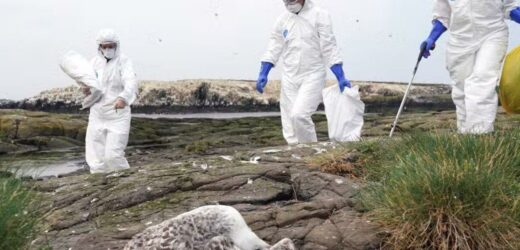Experts have issued a stark warning over a looming rise in bird flu cases in the UK this year. A significant wave of avian flu, which has already killed millions of birds in Britain, is poised to grow worse in the spring. Ornithologists warned last week that the virus, which has killed 208 million birds around the world and has reached at least 200 recorded cases in mammals, could even see a jump to humans. The disease is caused by the H5N1 strain of the virus and it has already started spreading like wildfire across British bird farms.
How many cases have been recorded in the UK?
In the UK, cases have been identified in Durham, Cheshire and Cornwall in England – along with Powys in Wales, Shetland, the Inner Hebrides and Fife in Scotland, to name a few. However, the arrival of new wild birds could make this worse.
Claire Smith, senior conservation officer for the RSPB told the Guardian: “Wild birds arriving in Britain in a couple of months are very likely to trigger new outbreaks of the disease. A few months ago, I was relatively optimistic about its likely impact this year but outbreaks have continued throughout winter and the outlook for 2023 now looks much grimmer.”
French news network France24 has also reported rapid signs of the disease taking off, saying they are “gathering pace”. It says European data shows that in autumn 2022 the epidemic had 35 percent higher recorded cases.

We use your sign-up to provide content in ways you’ve consented to and to improve our understanding of you. This may include adverts from us and 3rd parties based on our understanding. You can unsubscribe at any time. More info

Over the past two years, the virus has infected 65 species of bird in total. This includes 16,000 barnacle geese, which dies Solway Firth last winter. And more than a quarter of the UK’s only roseate tern colony off the Northumberland coast died over the summer.
But Ms Smith warned more birds are starting to die off too. These induce hen harriers and white-tailed eagles, which are both species are of conservation concern. She said: “We are seeing kestrels and owls becoming infected – probably because they are catching mice and voles that have picked up the virus from poultry farms. These rodents are not necessarily affected by the virus but they are carrying it.”
Meanwhile, the Animal and Plant Health Agency (APHA) has also tested 66 mammals. It found that nine otters and foxes tested positive for the H5N1 strain.
However, all but one of these cases occurred in 2021 or 2022. For now, the current rate at which the virus is circulating in the country is somewhat unclear.

Ms Smith said: “The main problem we face is that we do not know exactly how prevalent this strain of bird flu has become. We need to do a great deal of proactive testing to find how much the virus has spread among our wild birds and the government is not doing that.”
Animals that ingest wild-bird droppings, or that prey on infected animals, can also develop the disease. But last month, experts warned over the H5N1 strain of avian influenza after an outbreak in Spain suggested that the flu can spread from one infected mammal to another.
Hualan Chen, a virologist at the Harbin Veterinary Research Institute in China, has previously warned that the spread of the H5N1 strain between mammals could “pose a higher risk to public health”.
The H5N1 strain resulted in one human death in Britain since its most recent outbreak which began in October 2021.
DON’T MISS
Deer found carrying old Covid variants no longer in human circulation [REPORT]
Vikings transported dogs and horses to Britain on raiding trips INSIGHT]
Little known log burner rule which may result in £300 on-the-spot fine [REVEAL]


Since October 2022, there have been 144 cases in England, 20 cases in Scotland, 3 in Wales and 1 case in Northern Ireland.
The latest confirmed case occurred at a commercial housed poultry farm on October 11 2022 at premises near Watlington, King’s Lynn and West Norfolk.
A 3km protection zone and a 10km surveillance zone were quickly set up, but following successful disease control measures the zones were later revoked.
The UK’s national avian flu taskforce is now ramping up its surveillance of cases in mammals and genome analysis of the virus while keeping a close eye on the spread in global populations of wild birds.
Last year, the avian flu outbreak forced more than a third of poultry farms to introduce control measures to reduce the spread of the disease, whether they had been directly affected by an outbreak or not.
Source: Read Full Article


